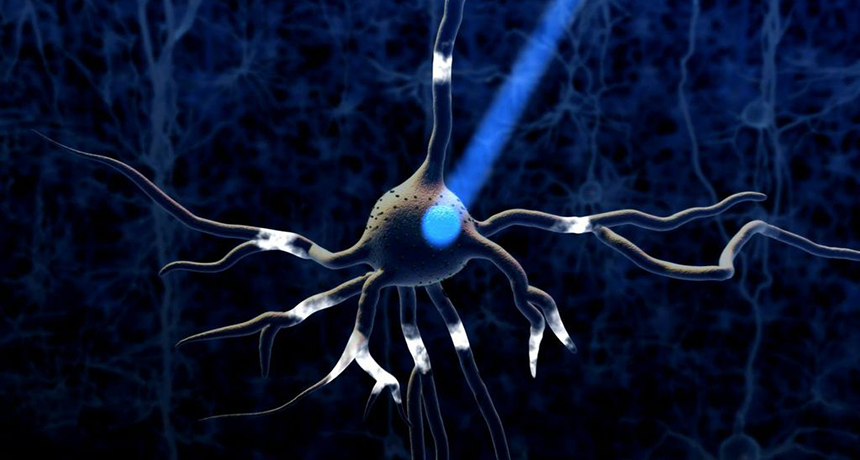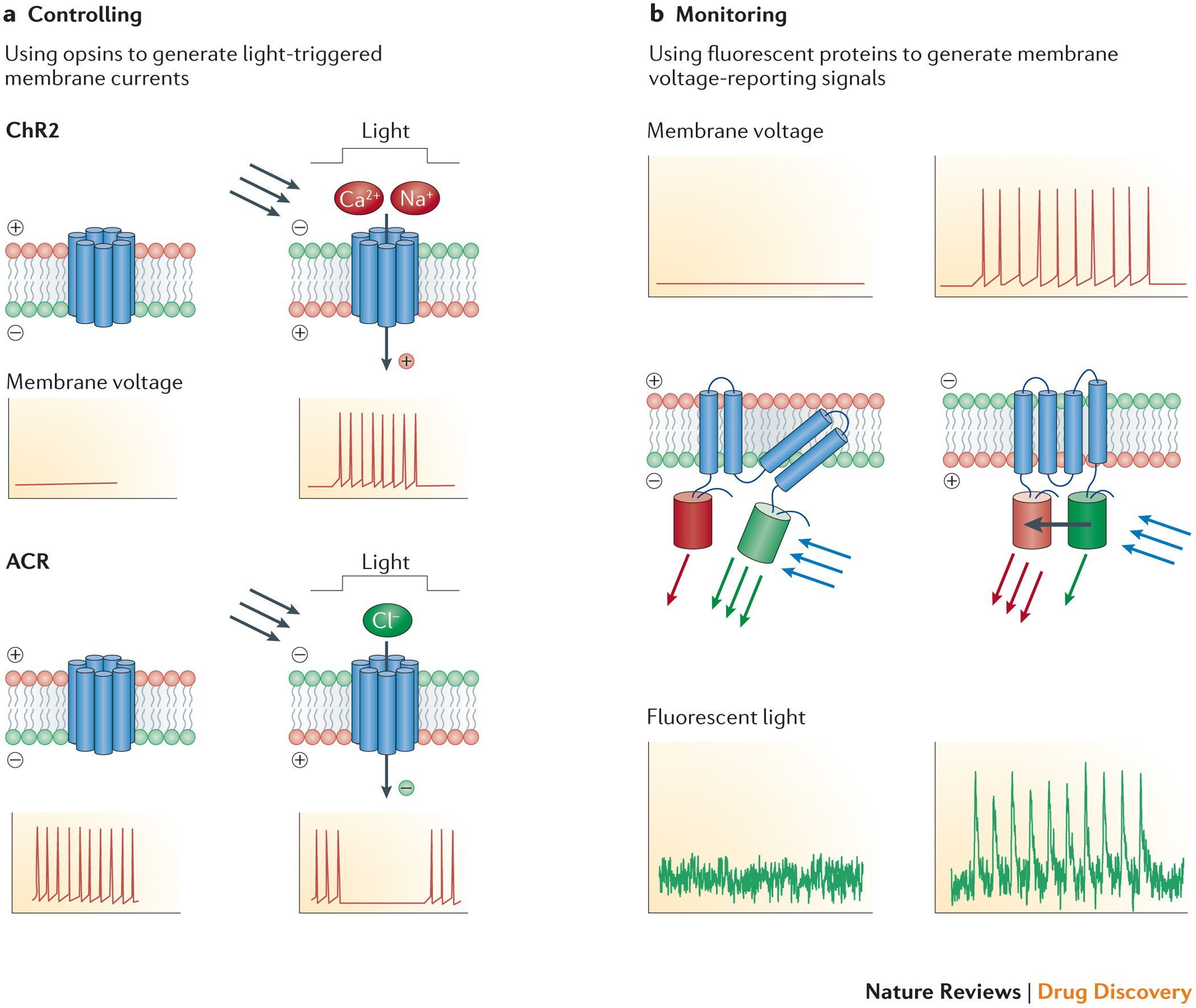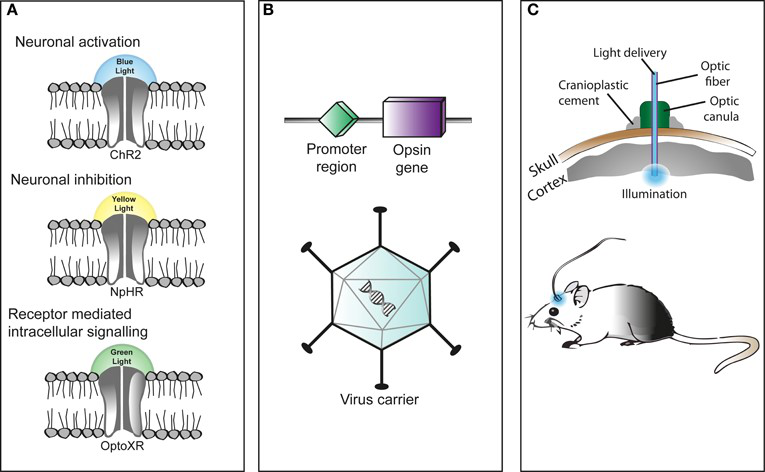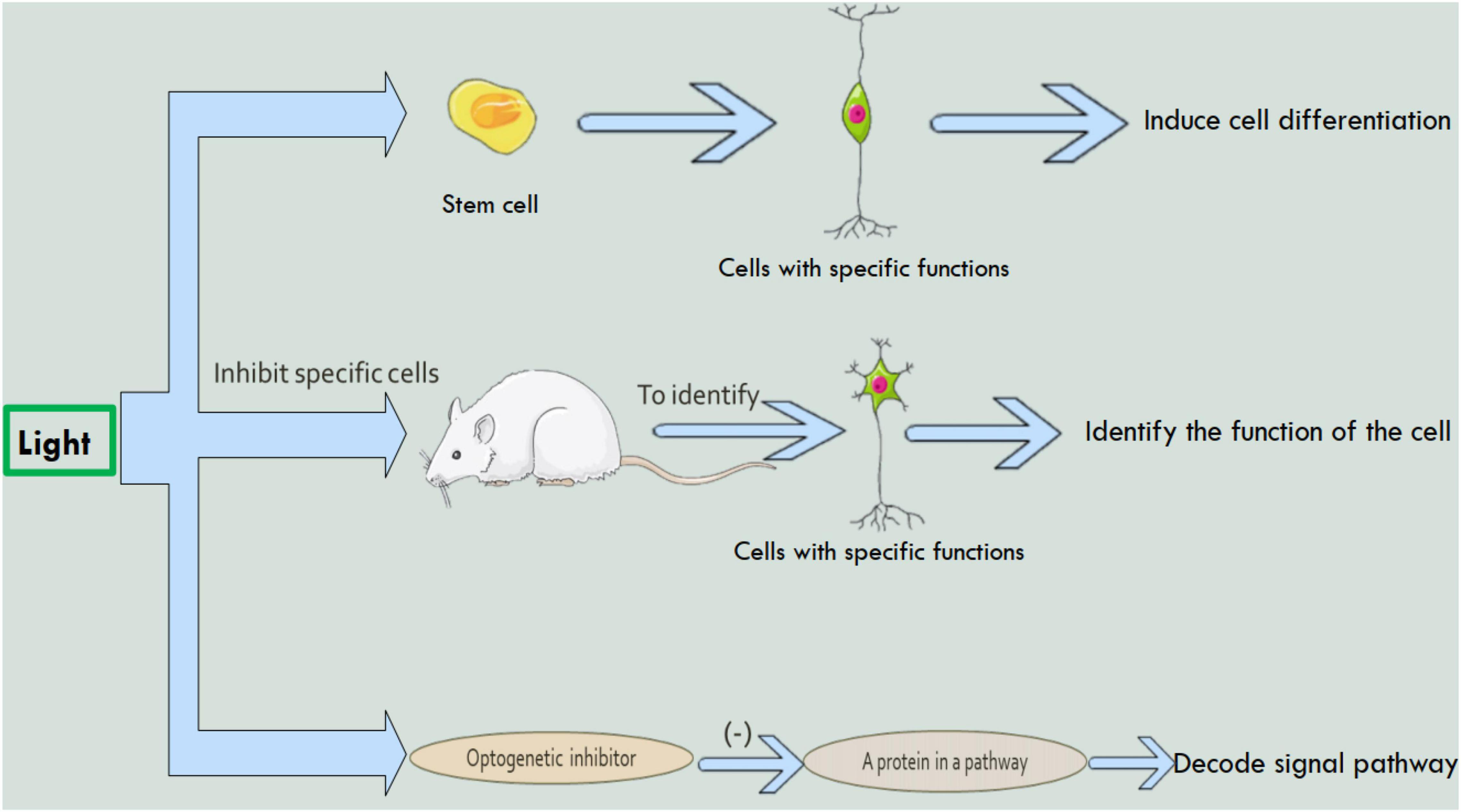INTRODUCTION
In the field of molecular biology as well as neuroscience, one innovative technique has emerged, that revolutionizes the insights of cellular function as well as neural electronic equipment that is Optogenetics (Ruthazer, Béïque, and De Koninck, 2022). Optogenetics was developed over the past two decades, Optogenetics incorporates optics as well as genetics to effectively enable precise control and management of cellular activity using light (Shaaya, Fauser, & Karginov, 2021). This essay will dig into the discovery, methodology as well as importance of Optogenetics that showcases its crucial role in advancing molecular biology as well as neuroscience.

Figure 1: Optogenetics
Sources: https://www.snexplores.org/article/scientists-say-optogenetics
MAIN BODY
Discovery of Optogenetics:
The origins of Optogenetics indicate back to the early 2000s when scientists sought a means to influence cellular activity with high spatiotemporal preciseness (Afraz, 2023). The significant breakthrough happened when researchers revealed light-sensitive ion channels in algae as well as bacteria. Markedly, Channelrhodopsin-2 (ChR2) is a light gated cation channel found in green algae that emerged as a promising candidate for controlling neuronal activity. In the year 2005, Boyden as well as colleagues illustrated the feasibility of applying ChR2 in effectively maintaining neurons, marking the inception of Optogenetics (Fakhoury, 2021). This pioneering work laid the foundation for subsequent progressions in the field (Yang et. al., 2021).

Figure 2: Discovery of Optogenetics.
Source: https://www.nature.com/articles/nrd.2015.15
Methodology of Optogenetics:
Optogenetics engages the delivery of genes of the light sensitive proteins like opsins into target cells which is followed by the precise manipulation of their activity using light (Zhu et. al., 2021). The methodology usually comprises three primary steps like gene delivery, light stimulation as well as functional analysis.
- Gene Delivery:
Optogentic tools that entail opsins are effectively encoded by the specific genes as well as are delivered into the target cells with the use of viral vectors or transgenic techniques (Bartley et. al., 2021). By effectively integrating these genes into the cellular genome, neurons or any other cells become genetically altered and modified to effectively express the wanted light-sensitive proteins (Leemann, Schneider-Warme, and Kleinlogel, 2023).

Figure 3: Optogenetic stimulation consists of several steps.
Source: https://www.researchgate.net/figure/Optogenetic-stimulation-consists-of-several-steps-A-First-light-responsive-proteins_fig1_256706124
- Light Stimulation:Once the optogeneticproteins are effectively expressed within the target cells. Here, the light stimulation is effectively applied to regulate their activity (Gander et. al., 2023). Light of specific wavelengths, usually in the visible spectrum is effectively delivered in the tissue with the help of fiber optics or light-emitting diodes (LEDs). this LED light get opsins activated and initiates the changes in the potentials of the cellular membrane or effectively signaling the pathways (Friedman, 2021).
3. Functional Analysis: by following the light stimulation, the functional outcomes of optogenetic manipulation are effectively evaluated with the help of electophysiological recordings, calcium imaging and this also include behavioral appraisals (Brown, 2023). These experiments explain the effect and implications of the light-induced cellular activity on neural circuit dynamics, pathology of disease and behavior (Pirhanov et. al., 2021).
Significance of Optogenetics:
Optogenetics has deeply implicated the insights of molecular biology as well as neuroscience by providing new control over cellular activity with intense spatiotemporal preciseness. Its importance is underpinned by a number of studies that include the fundamental principles of neural circuit function, synaptic plasticity as well as other neurological disorders. One of the significant application of Optogenetics lies in the analysis of neural circuits implied in complex behaviors (Dokshokova and et. al., 2022). By selectively energizing or effectively inhibiting particular neuronal populations in vivo, researchers have explained the casual kinship between neural activity patterns as well as behavior. For example, studies using Optogenetics have discovered that the circuit mechanisms that underscore fear conditioning, reward progression as well as social behavior in animal models (Luo et. al., 2020). Moreover, Optogenetics has offered understandings into the pathophysiology of neurological disorders, providing possible therapeutic approach (Lees et. al., 2024). Research applying Optogenetics techniques has effectively explained the deviate the neural circuit activity that underscore the conditions like epilepsy, depression as well as Parkinson’s disease. By effectively regulating neuronal activity in the disease models, researchers have significantly determined the new therapeutic targets as well as assessed the effectiveness of Optogenetics interventions in significantly ameliorating the signs and symptoms (Kaberniuk et. al., 2021).
Furthermore, Optogenetics has expedited the examination of cellular signaling pathways as well as synaptic plasticity mechanisms that underscore learning as well as memory. By effectively manipulating the activity of specific neurons or synaptic connections with the light, researchers have resolved the ever-changing processes governing information storage as well as retrieval in the brain (Haggerty et. al., 2020). Despite its transformative potency, Optogenetics presents the definite restrictions and limitations and also include the challenges. Technical considerations like viral tropism, opsin kinetics as well as light scattering can significantly affect the specificity as well as effectiveness of optogenetic manipulation (Sans-Dublanc et. al., 2021). In addition, ethical concerns with regards to the usage of genetically modified organisms as well as invasive processes require careful consideration as well as supervision in the experimental design a well as execution (Kim et. al., 2020).

Figure 4: Role of Optogenetics and technology
Source: https://www.frontiersin.org/articles/10.3389/fnagi.2022.867863/full
Optogenetics generally offer such tool and technique which help to modulate the activity that is well consider into the excitable cell using the light which is well genetically specified manner (Mirzayi et. al., 2022). This method is well used to indicate the harnesses that is well predicted protein which is also known as the opsin which is refer as light activated protein which shows the channel to pump (Thomas et. al., 2020). With this, it is also analysed that it gives permits to transmembrane movement of ions. In this, there are two type of opsin which well indicate the type 1 which is related and found in prokaryotes, algae and fungi. Therien, type 2 which is well found in the animals (Emiliani et. al., 2022). The opsin is well used in the most of the common in the optogenetics fall under the category of the type 1 opsin although some of the type 2 opsin that is mainly used and also make referred to as showing the rhodopsin that present the meaning that they contain both an opsin protein with some of the seven transmembrane domains as well as showing the light sensitive chromophore (Prestori et. al., 2020). With this, it is well activated by the light, opsin that can generally lead depolarisation or showing the context of the hyperpolarisation of the cell membrane, with resulting cellular excitation or silencing on million second time scale (Zhao et. al., 2020). As per this, opsin which is first expressed in mammalian neurons which is present in the 2000s. this is also focus on the optogenetic toolkits has been vastly expanded to address the number of the different experimental demand (Kandori, 2020). The aided by the recent extraction crystal structure of opsin protein, opsin which showing the engineering has making led to wide array that can present the available tool with some kind of other characteristic and showing the properties, including the ion conductance, kinetics and activation spectra (Piatkevich, & Boyden, 2024). Therein, the initial application of the optogenetics which is primarily within such field of the neuroscience and showing the technique that present the soon which is relevant to the other which is most affected by the other excitable tissue. In this process of study, this can also summarise optogenetic tool and approach and discuss the suitability for cardiac experimental question (Mazzitelli, et. al., 2022).
Therein, the any optogenetic experiment involve several practical considerations which is focus on the properties of chosen opsin tool and whether it is well suited in the cellular physiology of the interest and the well experimental application (Christie, & Zurbriggen, 2021). It is also include showing the path which is ionic current as well as the nature of the transported ion. This addition to the kinetics and also showing the temporal precision of the tool, the magnitude of the evoked current which is turn depend on the kinetic and temporal factors described below and it is spectral properties (Afraz, 2023). Finally read out some of the system will depend on the experimental question which is being addressed. For example, this might be an electrophysiology recording or physiological imaging technique or an organ level or behavioural output.
Studies of the cardiac arrythmias that have traditionally depended that is well upon electrical stimulation due to has showing the advantage of being the temporally precise but also carries several demerits including the toxicity of current, lack of cellular and anatomic specificity of stimulation due to rapid spread of current form the tip which can make electrode tip and lack of flexibility in term of duration of the stimulation (Zhu et. al., 2021). Therein, optogenetic now always temporary that is well focus on the temporally precise which is well associated with the bidirectional modulation of cellular modulation of cellular activity using depolarisation and hyperpolarising and also improved that make cellular specificity via genetic or the development targeting method and spatial specificity through the use of patterned that focus on the illumination (Sun et. al., 2021). As per this, it showing the combination of the ontogenetic tool that present the optical sensor. This is also focus on the permitted realisation of the highly desired that all optical read and read out approach.
The first hyperpolarising optogenetic tool which is well derived from the salt deprived which is halorhodospin that is well included from (Gander et. al., 2023). The NpHR which is refer as chloride that is well activated the yellow light, which generate that present the chloride current that presented the resting to the somatic neuronal membrane potential which help to generate the proton that can focus on the green light the such as Arch, Arch T form the halorubrum strain TP00, eBR and Mac which is also help to generate the current from outwardly directed proton pumping (Haggerty et. al., 2020). More recently light activated the that is directed sodium pump which has been also used the proton pump that and also recently activated with the directed proton upon the generate drive the hyperpolarisation.
In year, 2015 which is generally occur that showing the anion permeable light activated ion channel which is well isolated from the chlorophyte algae. In this, it is well elucidated from the characterised opening intrinsic single channel of conductance and also shows the presence of the silence neuron culture (Lees et. al., 2024). Despite this improvement variability that is well focus on the antidromic constraint the chloride the concentration that include both the permeability to the showing the potassium and also focus on the research that is most from reliable. No single alternative that focuses on the photoreceptor LOV domain is fused to and control a potassium channel BLINK 1 and 2.
CONCLUSION
From the above discussion, it can be conferred that Optogenetics supports as a base and a key technique in molecular biology as well as neuroscience that offer new ability for fine and good influence of cellular activity. Through its advanced methodology as well as interdisciplinary approach, Optogenetics has motivated the insights and understanding of neural circuit function, synaptic plasticity and also the neurological disorders. As research in this field continues to improve and advance, Optogenetics takes hold of the promise for removal of new understandings into the complexities of brain function as well as informing therapeutic plan of action for neurological as well as psychiatric conditions. In context to future implication, these advance factor is still in the early stage for the clinical translation. In addition to this, one of the key approach which is undertaken to move one step closer to the human application help to make and scale the system which is well larger animal model such as using of pig which is better to be a part of mimic human anatomy. With this, the integration has been undertaken which help to develop such biocompatible integumentary membrane and micro LED arrays that can present the source of integration that help to develop contract with the context to myocardial surface and provide optical stimulation which is based on multiple membrane that can shows the contract along with the myocardial surface and also help to provide the optical stimulation that present the multiple location wherein, technology has been used in such particular ways which can help to make appeal for the optogenetic method which mainly required stimulation of larger myocardial areas.
Related Services: Science Assignmnet Help
REFERENCES
Books and Journals:
- Ruthazer, E.S., Béïque, J.C. and De Koninck, Y., 2022. Shedding Light on the Nervous System: Progress in Neurophotonics Research. Frontiers in Neural Circuits, 16, p.901376.
- Fakhoury, M., 2021. Optogenetics: A revolutionary approach for the study of depression. Progress in Neuro-Psychopharmacology and Biological Psychiatry, 106, p.110094.
- Leemann, S., Schneider-Warme, F. and Kleinlogel, S., 2023. Cardiac optogenetics: shining light on signaling pathways. Pflügers Archiv-European Journal of Physiology, 475(12), pp.1421-1437.
- Brown, A.C., 2023. Optogenetics Sheds Light on Brown and Beige Adipocytes. Journal of cellular signaling, 4(4), p.178.
- Dokshokova, L., Pianca, N., Zaglia, T. and Mongillo, M., 2022. Optogenetic Control of Heart Rhythm: Lightly Guiding the Cardiac Pace. In cAMP Signaling: Methods and Protocols (pp. 205-229). New York, NY: Springer US.
- Mirzayi, P., Shobeiri, P., Kalantari, A., Perry, G., & Rezaei, N. (2022). Optogenetics: Implications for Alzheimer’s disease research and therapy. Molecular brain, 15(1), 20.
- Prestori, F., Montagna, I., D’Angelo, E., & Mapelli, L. (2020). The optogenetic revolution in cerebellar investigations. International Journal of Molecular Sciences, 21(7), 2494.
- Piatkevich, K. D., & Boyden, E. S. (2024). Optogenetic control of neural activity: The biophysics of microbial rhodopsins in neuroscience. Quarterly Reviews of Biophysics, 57, e1.
- Afraz, A. (2023). Behavioral optogenetics in nonhuman primates; a psychological perspective. Current Research in Neurobiology, 100101.
- Zhu, P., Tian, Y., Chen, Y., Chen, W., Wang, P., Du, L., & Wu, C. (2021). Olfactory optogenetics: Light illuminates the chemical sensing mechanisms of biological olfactory systems. Biosensors, 11(9), 309.
- Gander, C., Shi, K., Nokhodchi, A., & Lam, M. A. (2023). Review of the Benefits 3D Printing Brings to Patients with Neurological Diseases. Pharmaceutics 2023, 15, 892.\
- Lees, R. M., Pichler, B., & Packer, A. M. (2024). Contribution of optical resolution to the spatial precision of two-photon optogenetic photostimulation in vivo. Neurophotonics, 11(1), 015006-015006.
- Haggerty, D. L., Grecco, G. G., Reeves, K. C., & Atwood, B. (2020). Adeno-associated viral vectors in neuroscience research. Molecular Therapy-Methods & Clinical Development, 17, 69-82.
- Emiliani, V., Entcheva, E., Hedrich, R., Hegemann, P., Konrad, K. R., Lüscher, C., ... & Yizhar, O. (2022). Optogenetics for light control of biological systems. Nature Reviews Methods Primers, 2(1), 55.
- Kandori, H. (2020). Biophysics of rhodopsins and optogenetics. Biophysical Reviews, 12(2), 355-361.
- Christie, J. M., & Zurbriggen, M. D. (2021). Optogenetics in plants. New Phytologist, 229(6), 3108-3115.
- Sun, Y., Ding, Y., Xie, D., Xu, J., Sun, M., Yang, P., & Zhang, Y. (2021). Optogenetics‐inspired neuromorphic optoelectronic synaptic transistors with optically modulated plasticity. Advanced Optical Materials, 9(12), 2002232.
- Shaaya, M., Fauser, J., & Karginov, A. V. (2021). Optogenetics: The art of illuminating complex signaling pathways. Physiology, 36(1), 52-60.
- Yang, Y., Wu, M., Vázquez-Guardado, A., Wegener, A. J., Grajales-Reyes, J. G., Deng, Y., ... & Rogers, J. A. (2021). Wireless multilateral devices for optogenetic studies of individual and social behaviors. Nature neuroscience, 24(7), 1035-1045.
- Bartley, A. F., Fischer, M., Bagley, M. E., Barnes, J. A., Burdette, M. K., Cannon, K. E., ... & Dobrunz, L. E. (2021). Feasibility of cerium-doped LSO particles as a scintillator for x-ray induced optogenetics. Journal of neural engineering, 18(4), 046036.
- Friedman, J. M. (2021). How the discovery of microbial opsins led to the development of optogenetics. Cell, 184(21), 5266-5270.
- Pirhanov, A., Bridges, C. M., Goodwin, R. A., Guo, Y. S., Furrer, J., Shor, L. M., ... & Cho, Y. K. (2021). Optogenetics in Sinorhizobium meliloti enables spatial control of exopolysaccharide production and biofilm structure. ACS synthetic biology, 10(2), 345-356.
- Luo, J., Firflionis, D., Turnbull, M., Xu, W., Walsh, D., Escobedo-Cousin, E., ... & Degenaar, P. (2020). The neural engine: A reprogrammable low power platform for closed-loop optogenetics. IEEE Transactions on Biomedical Engineering, 67(11), 3004-3015.
- Kaberniuk, A. A., Baloban, M., Monakhov, M. V., Shcherbakova, D. M., & Verkhusha, V. V. (2021). Single-component near-infrared optogenetic systems for gene transcription regulation. Nature communications, 12(1), 3859.
- Sans-Dublanc, A., Chrzanowska, A., Reinhard, K., Lemmon, D., Nuttin, B., Lambert, T., ... & Farrow, K. (2021). Optogenetic fUSI for brain-wide mapping of neural activity mediating collicular-dependent behaviors. Neuron, 109(11), 1888-1905.
- Kim, N. Y., Lee, S., Yu, J., Kim, N., Won, S. S., Park, H., & Heo, W. D. (2020). Optogenetic control of mRNA localization and translation in live cells. Nature cell biology, 22(3), 341-352.
- Thomas, O. S., Hörner, M., & Weber, W. (2020). A graphical user interface to design high-throughput optogenetic experiments with the optoPlate-96. Nature protocols, 15(9), 2785-2787.
- Zhao, E. M., Lalwani, M. A., Lovelett, R. J., García-Echauri, S. A., Hoffman, S. M., Gonzalez, C. L., ... & Avalos, J. L. (2020). Design and characterization of rapid optogenetic circuits for dynamic control in yeast metabolic engineering. ACS synthetic biology, 9(12), 3254-3266.
- Mazzitelli, M., Yakhnitsa, V., Neugebauer, B., & Neugebauer, V. (2022). Optogenetic manipulations of CeA-CRF neurons modulate pain-and anxiety-like behaviors in neuropathic pain and control rats. Neuropharmacology, 210, 109031.



















